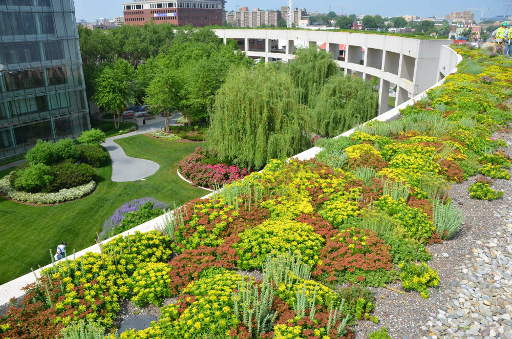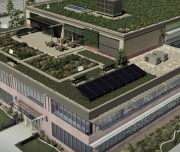Financial Impact

Bureau of Alcohol, Tobacco, Firearms and Explosives (ATF) Planted Roof
The decision of whether to install a planted roof should be considered on a case-by-case basis. Variability in structure, municipality, ownership, tenant, investment, technology, climate and other aspects requires specific attention to ensure accuracy.
It can be difficult to make the financial case for planted roofs due to the higher installation costs compared to conventional roofs. A life cycle analysis of each can counter these concerns. The added cost of installing a planted roof is mostly offset by its increased longevity; however, the added maintenance costs can be significant. Over a 50-year period, the stormwater, energy, carbon dioxide equivalent (CO2e, which measures the potential global warming effect of a greenhouse gas) and community earnings of planted roofs often more than make up for the increased premium of installing and maintaining them.
Planted roofs provide an estimated payback (based on a 50-year average annual savings) of approximately 6.2 years nationally (internal rate of return of 5.2%) and 6.6 years in Washington DC (internal rate of return of 4.2%). Conservative analysis puts the average life expectancy of a planted roof at 40 years, versus 17 for a conventional roof.1
1. The Benefits and Challenges of Green Roofs on Public and Commercial Buildings
When making roofing project decisions, you should compare the life cycle cost of the proposed planted roof to the conventional option for your facility (often a white or black roof). See Life Cycle Perspective for additional guidance. A generic cost-benefit analysis of planted roofs versus black roofs, at both the national level and Washington, DC level, is available from GSA's Green Roof page.
When comparing roof options, remember to include the following in both life cycle analyses:
- Inflation
- Growth rates for labor and materials, energy, and stormwater
- Diminishing returns (based on expected increase in supply)
- Discount rate
- Standardized timeline (recommended 50 years)
- Cost of the roof membrane (required for all new roofs and most replacements)
It is also important to consider the increase in real estate value associated with installing a planted roof. A planted roof can count toward certifications such as LEED and Energy Star. A 2011 CoStar study found that "Non-LEED buildings had 4.81% lower average rents than the broader market while LEED buildings were 7.38% higher."2 The Rocky Mountain Institute found that LEED and Energy Star buildings claim an 11-26% sales price premium.3
Be sure to consider the impact of a planted roof on your facility’s risk, as this is often not captured in a life cycle analysis. For example, an extensive planted roof can function as a preventive fire break, which lowers the risk of fire spreading. This may be reflected in the life cycle analysis if it also lowers insurance premiums.
A planted roof enhances the performance of existing building systems (see System Bundling). This lowers the operating costs and, when replaced, result in capital cost reductions due to system downsizing.


